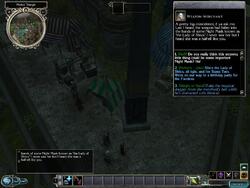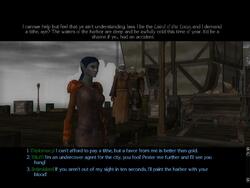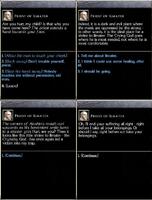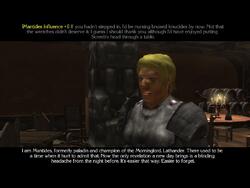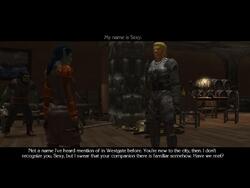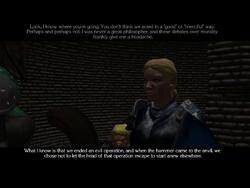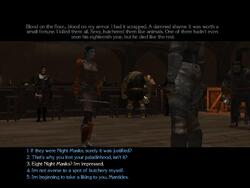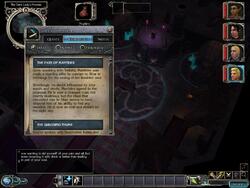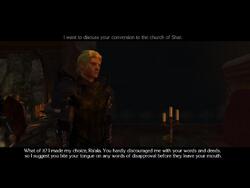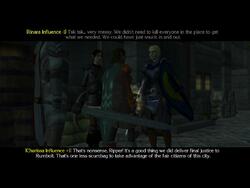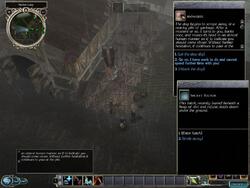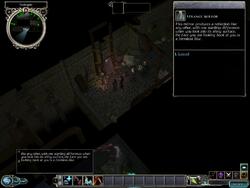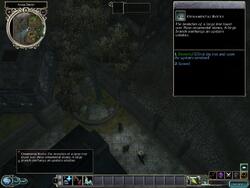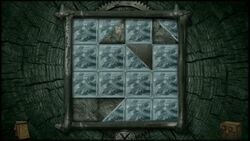NWN2: Mysteries of Westgate Review
NWN2: Mysteries of Westgate Review
Review - posted by baby arm on Sun 17 May 2009, 01:58:05
Tags: Neverwinter Nights 2: Mysteries of Westgate; Ossian StudiosOur dear Ubersturmfuhrer Vault Dweller plunked down his ten bucks to get a crack at Ossian's Neverwinter Nights 2 adventure pack, Mysteries of Westgate.
Here's his review.
Here's his review.
review by Vault Dweller
Mysteries of Westgate is the 4th Neverwinter Nights 2 game, which greatly increases the chance of you being sick and tired of the same engine, same awful-looking cutscenes, same bastardized real-time DnD, same chaotic combat that makes you think that the Infinity Engine combat wasn't that bad, same magic missiles, +1 weapons, etc. It’s also a 2 year old game, courtesy of Atari – a publisher of legendary, epic, and quite possibly the next-generation incompetence.
So, the main question is “what does this game offer that NWN2 OC, Mask of the Betrayer, and Storm of Zehir don’t?” Why should I play another NWN2 game? You can’t possibly tell me that it’s better than MotB or more innovative than SoZ? No, I can’t. And yet it’s one of the best NWN games and if MotB wasn’t Planescape’s distant cousin, I would have said that it’s the best NWN game.
The Urban Setting
Unlike Mask of the Betrayer, Mysteries of Westgate never leaves Kansas, never takes you on an awe-inspiring adventure across awe-inspiring planes, never introduces your to awe-inspiring characters or gives you awe-inspiring powers. MoW takes familiar concepts and does clever things with them. That's the key difference between MotB and MoW: MotB is awe-inspiring, MoW is plain but clever.
The game takes place in Westgate, which looks like a generic NWN2 town. You can see that the artists tried and there are plenty of details if you have an eye for them, but overall, Westgate doesn’t offer you anything you haven't seen before and you'll never have a reason to say "wow!" when entering a new area, but - and that's one hell of a but - you'll have plenty of reasons to say "that's some clever design", and since clever design rarely makes more than cameo appearance these days, it's more than enough to compensate for all the engine-inherited shortcomings.
You'll visit four districts: the slum-like Harbor, the Market Triangle - a middle-class trading district, the Arena district with mansions, the City Watch, a Church of Lathander, and finally the Undergate - a popular underground hangout in the city sewers. The atmosphere is well done and Westgate actually does look like a town, clearly showing its Athkatla roots. The streets are filled with people and the town feels alive. You’ll run into beggars, pickpockets, street entertainers, hacksters, traders, customers, and even protesters. Different events (an explosion in a nearby house, a ghostly face in a window, drunks complaining about a merchant, adventurers being duped by the locals, etc) that take place throughout the game add to the atmosphere and gently push you toward not very obvious side quests.
Needless to say, you'll have to go back and forth between the districts, constantly unlocking new places of interest. The pace and the city map make traveling easy and painless, which shows the attention to detail and awareness of the traditional pitfalls. In many games, including Baldur's Gate 2 and especially The Witcher, traveling between areas ranges from tedious to painful. It's definitely not the case here. Each area has several exits, so you are always close to one, and once you exit an area the travel menu will give you a list of all main locations and will teleport you next to a building you wish to enter.
The Character System and Combat
You start the game at lvl 8 (and finish at lvl 14), which is DnD at its best. You already have some experience and a few feats under your belt, but the character development hasn't reached the point where levelling up and selecting new feats and spells lose focus and all meaning, and you become an unstoppable juggernaut, destroyer of worlds and walls. Well, maybe not walls, but you get my point. Since I assume that most people are either familiar with DnD or with NWN games, nothing more needs to be said.
Overall, combat is challenging and the encounters are well designed. The game has almost no filler combat, which greatly increases the atmosphere and further removes the game from the almost “action RPG” design of the original campaign.
I played all NWN2 games with a rogue/other class character, rarely paying attention to combat and focusing on skillchecks instead, and MoW is the first NWN2 game where I actually wished I had a more robust and combat-friendly character.
Story and Party Members
The story is simple. You have a mask - a symbol of the Night Masks, a well-known Westgate criminal organization, and this mask happened to be cursed. Letting other people worry about the safety of the world, you are primarily concerned with getting rid of the cursed mask and since the mask leads to Westgate, you hop on a ship and head there.
Since the Masks' modus operandi is "don't call us, we'll call you", you're going to need some help finding them. Two organizations offer their help, but help in Westgate doesn't come cheap, and you'll have to earn it. In other words, you'll either work for the Ebon Claws - the Mask's competition or for the Church of Lathander. This will be your first, but not the only choice.
You'll run into 3 party members: an evil rogue - she's a former Night Mask with a grudge, a cleric of Tyr - so lawful that she's practically evil, and a fallen paladin who is still undecided on which road to take, but that's where you come in.
When the game introduced me to a fallen paladin, I expected another Carth. Maybe Aerie. With a lot of whining and frowning. Instead the ex-paladin paid attention and learned from me. At some point he made a choice, inspired by my actions, and accepted an offer to became a champion of Shar, a truly evil and remorseless killer. He was given nice evil armor and an even nicer, evil two-hander. (Alternatively, you can help your ex-paladin to regain his paladinhood). Needless to say, I liked this development a lot. Well done, Ossian.
What I liked even more is that I told him "don't do it" in both cases (the above mentioned choices), but my influence was low and he rejected my opinion, especially since it contradicted with my gameplay choices.
The influence system is well done. Even negative influence kicks in every now and then. If you manage to really piss off the cleric and then tell her to do things a certain way, she will do the opposite just because it came from you. Pretty cool.
Quest Design
That's where we come to that clever and well-designed part. Instead of telling you what my biased opinion is, let me show you some examples:
Exhibit A:
A certain sage asks me to recover a very special gem that fell to the Undergate - Westgate's sewers and an underground hangout for people and creatures who appreciate the comfort of such places. Seems like a rather boring "go to the sewers, crack some skulls, get the gem" routine. Naturally, the gem fell into a troll cave - where else? I go in, kill several trolls, and make it to a door leading to the troll chieftain. I get it. A boss fight. I open the door and go in. The troll chieftain is dead. Freshly killed by another group of adventurers, who pocket my gem, tell me to fuck off, and teleport away. Now I have to figure out who these guys are and where to find them. A simple "fetch a gem" quest was turned into something a lot more interesting.
Exhibit B:
I enter a district and the first thing I see is an explosion in a nearby house. Business as usual in Westgate? A guard tells me to mind my business, but I go inside anyway. Several dead people, burnt to a crisp, and one almost dead guy. I heal him a bit, but he has amnesia. He doesn't remember anything at all, all he knows is that there is something important in this building and he can't leave until he figures out what it is. Since we don't have anything better to do, we start investigating and meddling.
Eventually we manage to find a way down. Suddenly two HUGE sea snakes appear out of a large pool of water, blocking our way. Being a natural born leader I calmly command "Marines! We. Are. Leaving Getting the fuck outta here!" During the tactical retreat chaos it becomes clear that both the sea snakes and the water are illusions. Good one, whoever you are.
We go further. Still no fights. No skeletons, henchmen, underlings. Inner chamber. No fights. One non-hostile dwarven servant. No fights. No ogres, goblins, nothing. A portal. I step in and then things start getting interesting. Several wizards are trying to prevent a lich trapped inside a crystal from getting out.
The lich recognizes my new companion. The amnesiac starts remembering, and before you realize what's happening, he completes the ritual setting the lich free. Turns out that he was the leader of a cult. The cult was in the middle of the ritual when the Harpers (the wizards) caused the explosion that killed almost everyone but the leader who would have bled to death if not for our involvement. Lucky for him, we healed him and brought him to the lich just in time to complete the ritual.
It's a simple quest and it doesn't have any alternative solutions or choices, but it's refreshing, enjoyable, and clever.
Exhibit C:
A guy asks you to help him get into a ruined (and hidden) temple of illusions. He wants a certain cloak, the rest is yours. You can agree or say that you'll decide later. When you enter the temple, you are confronted (peacefully) by a ghost of a priestess who warns you not to disturb the dead. The temple is pretty much empty. A few traps here and there. Some chests with junk. Then the ghost appears again and says that disturbing the rest of her sisters will be a bad thing to do. At that point my ex-paladin freaks out and says "Let's leave. I've broken so many of my vows, must I break all of them?" I tell him to man up, which cost me some influence and we enter the main chamber, immediately running into an ogre-mage with his buddies. Turns out the ogre-mage raided the temple and later used the cloak to conjure illusions to keep us away. We kill him, then the temporary party member raises the cloak question again. I tell him to fuck off, we fight, he dies, I keep the cloak - much rejoicing.
So, while the quest is straightforward, the option to turn back is well presented and well done. If you're role-playing a character who doesn't have a habit of disturbing the dead when asked nicely and who cares about the paladin's opinion, you would have a good reason to turn back, especially since you'd need the influence to keep the paladin from falling further. The option to let the temp keep the cloak or kill him is nice too.
Exhibit D:
I need to enter a manor, preferably quietly. There is a back door, which comes with the risk of being detected (creaking floor boards, so unless you can move silently....) and dealing with a servant upstairs (high diplomacy will prevent him from calling for help). Alternatively, you can climb a tree (Dex check) and get to a second floor's window. You can find everything you need there and leave the same way you came in. If you leave quietly, leaving the owner to his fate (which depends on whether you complete a secondary objective or not), it pleases the Rogue party member, who prefers subtlety, but displeases the Paladin and the bloodthirsty Cleric, who would have preferred - ironically - if you killed everyone.
Not a lot of consequences (other than the influence), but the options are well designed.
While the game has many straight forward quests, quite a few quests offer interesting role-playing opportunities and options. Let me give you some an example:
At some point the game requires you to acquire a token to enter a certain establishment. You can get a token from two places: a gambling addict or a powerful lizardfolk shaman who likes to eat people and has, apparently, eaten someone who had a token. If you decide to pay the shaman a visit, you have 3 options:
- the good old fashioned violence
- sneak in during the night when the shaman is hunting
- send in a sight-seeing "tourist" (tell him it's a cool place to visit) and then go in. You'll hear chewing noises from the main room.
The addict could be convinced, intimidated, or bribed (the unskilled option, basically). Bribing her will have negative consequences.
When you finally get to the establishment, you'll have a quick but unproductive chat with the illithid owner. It would seem that violence is the only option. It's not. The encounter can be resolved peacefully, but that requires a certain item that could be obtained in a not very obvious (missed it on the first playthrough - had no idea it was there, actually) side quest.
The design of the ending deserves a special praise. It is - without a doubt - the best and most brilliantly designed ending to ever grace the genre. The evil option is something that every RPG fan should experience. I kid you not. Ossian has significantly raised the bar there.
And in Conclusion:
To put it simply, Mysteries of Westgate is a game worth playing. Ossian Studio has successfully avoided the temptation of telling epic stories and improving dated visuals, and instead focused on the only thing that truly matters in the end - good design. If that's good enough for you, go and spend 10 bucks on the game, sending the developers a message that their efforts are noted and appreciated. If not…
Mysteries of Westgate is the 4th Neverwinter Nights 2 game, which greatly increases the chance of you being sick and tired of the same engine, same awful-looking cutscenes, same bastardized real-time DnD, same chaotic combat that makes you think that the Infinity Engine combat wasn't that bad, same magic missiles, +1 weapons, etc. It’s also a 2 year old game, courtesy of Atari – a publisher of legendary, epic, and quite possibly the next-generation incompetence.
So, the main question is “what does this game offer that NWN2 OC, Mask of the Betrayer, and Storm of Zehir don’t?” Why should I play another NWN2 game? You can’t possibly tell me that it’s better than MotB or more innovative than SoZ? No, I can’t. And yet it’s one of the best NWN games and if MotB wasn’t Planescape’s distant cousin, I would have said that it’s the best NWN game.
The Urban Setting
Unlike Mask of the Betrayer, Mysteries of Westgate never leaves Kansas, never takes you on an awe-inspiring adventure across awe-inspiring planes, never introduces your to awe-inspiring characters or gives you awe-inspiring powers. MoW takes familiar concepts and does clever things with them. That's the key difference between MotB and MoW: MotB is awe-inspiring, MoW is plain but clever.
The game takes place in Westgate, which looks like a generic NWN2 town. You can see that the artists tried and there are plenty of details if you have an eye for them, but overall, Westgate doesn’t offer you anything you haven't seen before and you'll never have a reason to say "wow!" when entering a new area, but - and that's one hell of a but - you'll have plenty of reasons to say "that's some clever design", and since clever design rarely makes more than cameo appearance these days, it's more than enough to compensate for all the engine-inherited shortcomings.
You'll visit four districts: the slum-like Harbor, the Market Triangle - a middle-class trading district, the Arena district with mansions, the City Watch, a Church of Lathander, and finally the Undergate - a popular underground hangout in the city sewers. The atmosphere is well done and Westgate actually does look like a town, clearly showing its Athkatla roots. The streets are filled with people and the town feels alive. You’ll run into beggars, pickpockets, street entertainers, hacksters, traders, customers, and even protesters. Different events (an explosion in a nearby house, a ghostly face in a window, drunks complaining about a merchant, adventurers being duped by the locals, etc) that take place throughout the game add to the atmosphere and gently push you toward not very obvious side quests.
Needless to say, you'll have to go back and forth between the districts, constantly unlocking new places of interest. The pace and the city map make traveling easy and painless, which shows the attention to detail and awareness of the traditional pitfalls. In many games, including Baldur's Gate 2 and especially The Witcher, traveling between areas ranges from tedious to painful. It's definitely not the case here. Each area has several exits, so you are always close to one, and once you exit an area the travel menu will give you a list of all main locations and will teleport you next to a building you wish to enter.
The Character System and Combat
You start the game at lvl 8 (and finish at lvl 14), which is DnD at its best. You already have some experience and a few feats under your belt, but the character development hasn't reached the point where levelling up and selecting new feats and spells lose focus and all meaning, and you become an unstoppable juggernaut, destroyer of worlds and walls. Well, maybe not walls, but you get my point. Since I assume that most people are either familiar with DnD or with NWN games, nothing more needs to be said.
Overall, combat is challenging and the encounters are well designed. The game has almost no filler combat, which greatly increases the atmosphere and further removes the game from the almost “action RPG” design of the original campaign.
I played all NWN2 games with a rogue/other class character, rarely paying attention to combat and focusing on skillchecks instead, and MoW is the first NWN2 game where I actually wished I had a more robust and combat-friendly character.
Story and Party Members
The story is simple. You have a mask - a symbol of the Night Masks, a well-known Westgate criminal organization, and this mask happened to be cursed. Letting other people worry about the safety of the world, you are primarily concerned with getting rid of the cursed mask and since the mask leads to Westgate, you hop on a ship and head there.
Since the Masks' modus operandi is "don't call us, we'll call you", you're going to need some help finding them. Two organizations offer their help, but help in Westgate doesn't come cheap, and you'll have to earn it. In other words, you'll either work for the Ebon Claws - the Mask's competition or for the Church of Lathander. This will be your first, but not the only choice.
You'll run into 3 party members: an evil rogue - she's a former Night Mask with a grudge, a cleric of Tyr - so lawful that she's practically evil, and a fallen paladin who is still undecided on which road to take, but that's where you come in.
When the game introduced me to a fallen paladin, I expected another Carth. Maybe Aerie. With a lot of whining and frowning. Instead the ex-paladin paid attention and learned from me. At some point he made a choice, inspired by my actions, and accepted an offer to became a champion of Shar, a truly evil and remorseless killer. He was given nice evil armor and an even nicer, evil two-hander. (Alternatively, you can help your ex-paladin to regain his paladinhood). Needless to say, I liked this development a lot. Well done, Ossian.
What I liked even more is that I told him "don't do it" in both cases (the above mentioned choices), but my influence was low and he rejected my opinion, especially since it contradicted with my gameplay choices.
The influence system is well done. Even negative influence kicks in every now and then. If you manage to really piss off the cleric and then tell her to do things a certain way, she will do the opposite just because it came from you. Pretty cool.
Quest Design
That's where we come to that clever and well-designed part. Instead of telling you what my biased opinion is, let me show you some examples:
Exhibit A:
A certain sage asks me to recover a very special gem that fell to the Undergate - Westgate's sewers and an underground hangout for people and creatures who appreciate the comfort of such places. Seems like a rather boring "go to the sewers, crack some skulls, get the gem" routine. Naturally, the gem fell into a troll cave - where else? I go in, kill several trolls, and make it to a door leading to the troll chieftain. I get it. A boss fight. I open the door and go in. The troll chieftain is dead. Freshly killed by another group of adventurers, who pocket my gem, tell me to fuck off, and teleport away. Now I have to figure out who these guys are and where to find them. A simple "fetch a gem" quest was turned into something a lot more interesting.
Exhibit B:
I enter a district and the first thing I see is an explosion in a nearby house. Business as usual in Westgate? A guard tells me to mind my business, but I go inside anyway. Several dead people, burnt to a crisp, and one almost dead guy. I heal him a bit, but he has amnesia. He doesn't remember anything at all, all he knows is that there is something important in this building and he can't leave until he figures out what it is. Since we don't have anything better to do, we start investigating and meddling.
Eventually we manage to find a way down. Suddenly two HUGE sea snakes appear out of a large pool of water, blocking our way. Being a natural born leader I calmly command "Marines! We. Are. Leaving Getting the fuck outta here!" During the tactical retreat chaos it becomes clear that both the sea snakes and the water are illusions. Good one, whoever you are.
We go further. Still no fights. No skeletons, henchmen, underlings. Inner chamber. No fights. One non-hostile dwarven servant. No fights. No ogres, goblins, nothing. A portal. I step in and then things start getting interesting. Several wizards are trying to prevent a lich trapped inside a crystal from getting out.
The lich recognizes my new companion. The amnesiac starts remembering, and before you realize what's happening, he completes the ritual setting the lich free. Turns out that he was the leader of a cult. The cult was in the middle of the ritual when the Harpers (the wizards) caused the explosion that killed almost everyone but the leader who would have bled to death if not for our involvement. Lucky for him, we healed him and brought him to the lich just in time to complete the ritual.
It's a simple quest and it doesn't have any alternative solutions or choices, but it's refreshing, enjoyable, and clever.
Exhibit C:
A guy asks you to help him get into a ruined (and hidden) temple of illusions. He wants a certain cloak, the rest is yours. You can agree or say that you'll decide later. When you enter the temple, you are confronted (peacefully) by a ghost of a priestess who warns you not to disturb the dead. The temple is pretty much empty. A few traps here and there. Some chests with junk. Then the ghost appears again and says that disturbing the rest of her sisters will be a bad thing to do. At that point my ex-paladin freaks out and says "Let's leave. I've broken so many of my vows, must I break all of them?" I tell him to man up, which cost me some influence and we enter the main chamber, immediately running into an ogre-mage with his buddies. Turns out the ogre-mage raided the temple and later used the cloak to conjure illusions to keep us away. We kill him, then the temporary party member raises the cloak question again. I tell him to fuck off, we fight, he dies, I keep the cloak - much rejoicing.
So, while the quest is straightforward, the option to turn back is well presented and well done. If you're role-playing a character who doesn't have a habit of disturbing the dead when asked nicely and who cares about the paladin's opinion, you would have a good reason to turn back, especially since you'd need the influence to keep the paladin from falling further. The option to let the temp keep the cloak or kill him is nice too.
Exhibit D:
I need to enter a manor, preferably quietly. There is a back door, which comes with the risk of being detected (creaking floor boards, so unless you can move silently....) and dealing with a servant upstairs (high diplomacy will prevent him from calling for help). Alternatively, you can climb a tree (Dex check) and get to a second floor's window. You can find everything you need there and leave the same way you came in. If you leave quietly, leaving the owner to his fate (which depends on whether you complete a secondary objective or not), it pleases the Rogue party member, who prefers subtlety, but displeases the Paladin and the bloodthirsty Cleric, who would have preferred - ironically - if you killed everyone.
Not a lot of consequences (other than the influence), but the options are well designed.
While the game has many straight forward quests, quite a few quests offer interesting role-playing opportunities and options. Let me give you some an example:
At some point the game requires you to acquire a token to enter a certain establishment. You can get a token from two places: a gambling addict or a powerful lizardfolk shaman who likes to eat people and has, apparently, eaten someone who had a token. If you decide to pay the shaman a visit, you have 3 options:
- the good old fashioned violence
- sneak in during the night when the shaman is hunting
- send in a sight-seeing "tourist" (tell him it's a cool place to visit) and then go in. You'll hear chewing noises from the main room.
The addict could be convinced, intimidated, or bribed (the unskilled option, basically). Bribing her will have negative consequences.
When you finally get to the establishment, you'll have a quick but unproductive chat with the illithid owner. It would seem that violence is the only option. It's not. The encounter can be resolved peacefully, but that requires a certain item that could be obtained in a not very obvious (missed it on the first playthrough - had no idea it was there, actually) side quest.
The design of the ending deserves a special praise. It is - without a doubt - the best and most brilliantly designed ending to ever grace the genre. The evil option is something that every RPG fan should experience. I kid you not. Ossian has significantly raised the bar there.
And in Conclusion:
To put it simply, Mysteries of Westgate is a game worth playing. Ossian Studio has successfully avoided the temptation of telling epic stories and improving dated visuals, and instead focused on the only thing that truly matters in the end - good design. If that's good enough for you, go and spend 10 bucks on the game, sending the developers a message that their efforts are noted and appreciated. If not…






